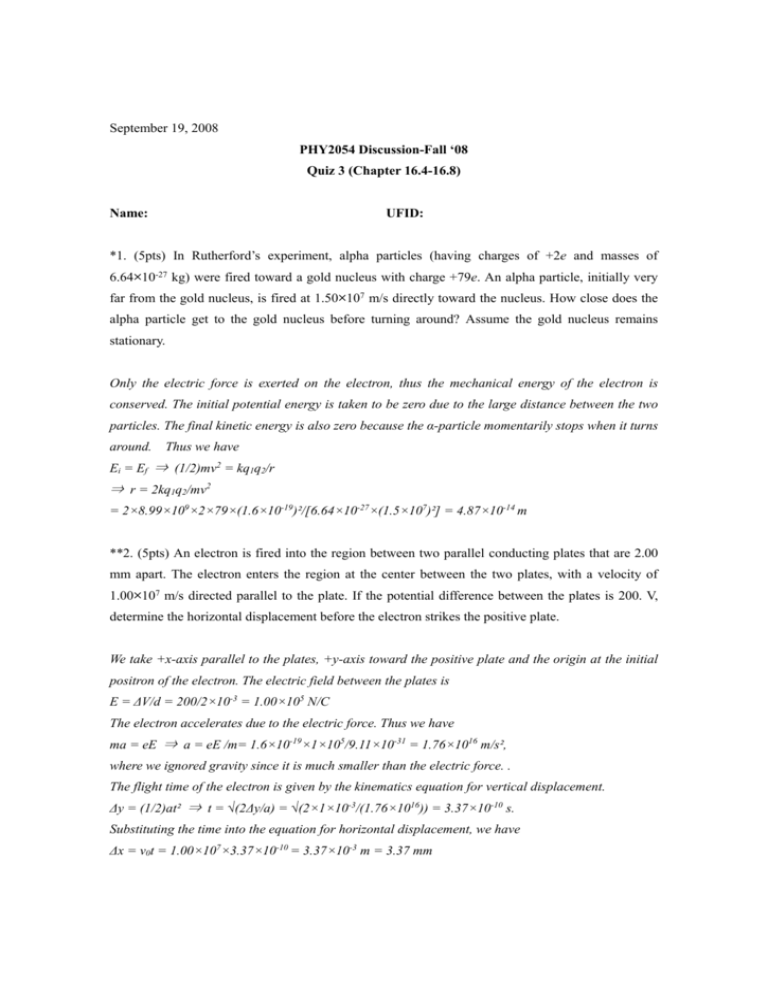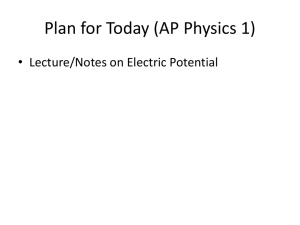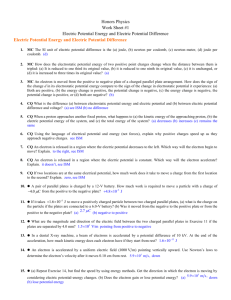August 29, 2007
advertisement

September 19, 2008 PHY2054 Discussion-Fall ‘08 Quiz 3 (Chapter 16.4-16.8) Name: UFID: *1. (5pts) In Rutherford’s experiment, alpha particles (having charges of +2e and masses of 6.64×10-27 kg) were fired toward a gold nucleus with charge +79e. An alpha particle, initially very far from the gold nucleus, is fired at 1.50×107 m/s directly toward the nucleus. How close does the alpha particle get to the gold nucleus before turning around? Assume the gold nucleus remains stationary. Only the electric force is exerted on the electron, thus the mechanical energy of the electron is conserved. The initial potential energy is taken to be zero due to the large distance between the two particles. The final kinetic energy is also zero because the α-particle momentarily stops when it turns around. Thus we have Ei = Ef ⇒ (1/2)mv2 = kq1q2/r ⇒ r = 2kq1q2/mv2 = 2×8.99×109×2×79×(1.6×10-19)²/[6.64×10-27×(1.5×107)²] = 4.87×10-14 m **2. (5pts) An electron is fired into the region between two parallel conducting plates that are 2.00 mm apart. The electron enters the region at the center between the two plates, with a velocity of 1.00×107 m/s directed parallel to the plate. If the potential difference between the plates is 200. V, determine the horizontal displacement before the electron strikes the positive plate. We take +x-axis parallel to the plates, +y-axis toward the positive plate and the origin at the initial positron of the electron. The electric field between the plates is E = ΔV/d = 200/2×10-3 = 1.00×105 N/C The electron accelerates due to the electric force. Thus we have ma = eE ⇒ a = eE /m= 1.6×10-19×1×105/9.11×10-31 = 1.76×1016 m/s², where we ignored gravity since it is much smaller than the electric force. . The flight time of the electron is given by the kinematics equation for vertical displacement. Δy = (1/2)at² ⇒ t = √(2Δy/a) = √(2×1×10-3/(1.76×1016)) = 3.37×10-10 s. Substituting the time into the equation for horizontal displacement, we have Δx = v0t = 1.00×107×3.37×10-10 = 3.37×10-3 m = 3.37 mm **3. (5pts) The combination below is connected across a 30.0-V battery. If C = 6.00 μF, what is the voltage drop across the leftmost capacitor? C 2C C 2C Let the capacitors be C1, C2, C3 and C4 from left to right. C3 and C4 are connected in series. Thus 1/C’ = 1/C1+1/C2 = 1/(2C)+1/(2C) = 1/C ⇒ C’ = C = 6 μF C2 and C’ are connected in parallel. Thus C” = C2+C’ = C+C = 2C = 12 μF C1 and C” are connected in series. Thus 1/Ceq = 1/C1+1/C” = 1/C + 1/(2C) = 3/(2C) ⇒ Ceq = 2C/3 = 4 μF Since C1 and C” are connected in series, the charge stored in C1 is equal to that stored in the equivalent capacitor. Q1 = Qeq = CeqΔV = 4×10-6×30 = 1.2×10-4 C = 120 μC Thus the voltage drop across C1 is ΔV1 = Q1/C1 = 120×10-6/(6×10-6) = 20.0 V ***4. (5pts) Three capacitors C1 = 12.0 μF, C2 = 4.00 μF and C3 = 3.00 μF are charged as a parallel combination across a 100-V battery. The three capacitors are disconnected from the battery and from one another. They are then connected in series in the order of C1, C2 and C3, and the negative plate of C3 is connected to the positive plate of C1. Calculate the resulting charge on C1. Before the circuit is rearranged, the charges stored in the capacitors are respectively Q1i = C1ΔV = 12×100 = 1200 μC, Q2i = C2ΔV = 400 μC & Q3i = C3ΔV = 400 μC The negative plate of C1 is combined to the positive plate of C2, thus we have -Q1+Q2 = -Q1i+Q2i = -1200+400 = -800 μC ⇒ Q2 = Q1-800 The positive plate of C1 is combined to the negative plate of C3, thus we have Q1-Q3 = Q1i-Q3i = 1200-300 = 900 μC ⇒ Q3 = Q1-900 Since the three capacitors are connected in series and there is no external voltage source in the circuit, we have 0 = ΔV1+ΔV2+ΔV3 = Q1/C1+Q2/C2+Q3/C3 = Q1/C1+(Q1-800)/C2+( Q1-900)/C3 ⇒ (C1C2+C2C3+C3C1)Q1 = 800C1C3+900C1C2 ⇒ Q1 = (800C3+900C2)C1/( C1C2+C2C3+C3C1) = (800×3+900×4)×12/(12×4+4×3+3×12) = 750 μC








